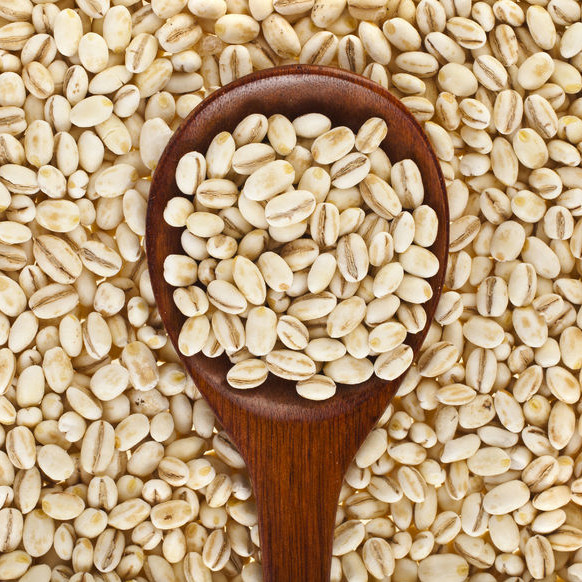
Barley
What is Barley?
Barley (Hordeum vulgare) is a flavorful and chewy grain that can be added to breads and other baked goods. It may be hulled or pearled, which can change a product’s final flavor and nutritional profile.1
Barley is a non-GMO crop typically available for culinary use in two forms:
- Hulled barley is minimally processed, with the bran and germ intact.
- Pearled barley has had the hull and bran layer removed.3, 4
Origin
As one of the oldest cultivated grains known, there is a rich history surrounding barley. It was used in religious ceremonies, depicted on currency, and was reputed to form the basis of English measurements. It remains the world’s fourth most important cereal crop after wheat, rice, and corn.2
Function
Barley is enjoying a renaissance in the craft and commercial baking sectors since it is considered an ancient grain and ongoing research attests to its health benefits. It is used in both flour and grain forms as well as in bran, whole or crushed grains, and flake forms.
Although it does contain gluten, breads made with it tend to be dense with a nominal rise. These flours are typically used with wheat flours. Some have suggested it is an ideal ingredient for bakers who appreciate a challenge.
Nutrition
When eaten as a whole grain, barley has several general nutritional benefits. Whole grains are typically high in fiber, iron, and B vitamins. It contains twice the protein and roughly half the calories of oats. The health benefits are commonly associated with the soluble beta-glucan fiber found in the grain.
A cup of hulled barley, weighing 184 grams (g) reportedly contains:
- 651 calories
- 22.96 g of protein
- 4.23 g of fat
- 0 g of cholesterol
- 135 g of carbohydrate
- 31.8 g of dietary fiber
- 61 milligrams of calcium
- 6.62 mg of iron
- 1.189 mg of thiamin
- 0.524 mg of riboflavin
- 8.471 mg of niacin
- 0.585 mg of vitamin B6
- 35 micrograms of folate
- 245 mg of magnesium
- 486 mg of phosphorus
- 832 mg of potassium
- 5.1 mg of zinc
The amount of each nutrient required daily varies by individual, based on factors such as age and gender.4
In studies, barley consumption was found to significantly reduce “bad cholesterol,” which is why several public health authorities, including Health Canada and the United States Food and Drug Administration, have approved health claims that barley lowers LDL cholesterol.5
Application
For baking, barley is most commonly an ingredient in breads. Several technical and sensory evaluations of flour from different varieties and different combinations of flour admixtures have been conducted worldwide. One examined acceptance of barley in breads and found those with a sourdough admixture scored higher for total taste than those without. The beta-glucan content was notable for only its contribution to the breadcrumb color.6, 7, 8
In barley-growing nations, significant work to increase its consumption has been ongoing. This includes milling research in the European Union designed to help preserve the beta-glucan fiber when processed. Beta-glucan-enriched bread products were also tested. Researchers expect health claims to matter to consumers; however, manufacturers need to carefully design and market their products.6
FDA regulation
The National Barley Foods Council petitioned the United States Food and Drug Administration in 2004 to recognize the ingredient and products made with it for its dietary fiber content for nutrition labeling and marketing claims. The final rule includes dry milled barley products as an eligible source of beta-glucan soluble fiber for health claims.9 Since 2005, the U.S. FDA has allowed barley foods to claim that they reduce the risk of coronary heart disease.2
References
- Muckian, Michael. “Bringing Ancient Grains to Market in Wisconsin.” Wisconsin Gazette, 11 Aug. 2017
- “Barley – February Grain of the Month.” Barley – February Grain of the Month | The Whole Grains Council, wholegrainscouncil.org. Last accessed 18 October 2018.
- “‘No Genetically Modified (GM) Varieties Approved for Commercial Production in North America.’” American Barley Malting Association
- Ware, Megan. “Barley: Health Benefits, Nutrition, Diet, and Risks.” Medical News Today, MediLexicon International, 15 Jan. 2018, www.medicalnewstoday.com. Last accessed 23 October 2018.
- Media, Cns. “Barley Lowers Two Types of ‘Bad Cholesterol’, Review Suggests.” Nutritioninsight.com/, www.nutritioninsight.com. Last accessed 23 October 2018.
- “Baking with Barley.” Bakers Journal, www.bakersjournal.com.
- Marklinder, I. et al. “Effects of Flour from Different Barley Varieties on Barley Sour Dough Bread.” , Food Quality and Preference, doi.org/10.1016/S0950-3293(96)00033-X. Volume 7, Issues 3–4, July–October 1996, Pages 275-284. Last accessed 18 October 2018.
- Mariotti, Manuela, et al. “Barley Flour Exploitation in Sourdough Bread-Making: A Technological, Nutritional and Sensory Evaluation.” LWT – Food Science and Technology, vol. 59, no. 2, Dec. 2014, pp. 973–980., doi:10.1016/j.lwt.2014.06.052. Last accessed 18 October 2018.
- Federal Register, Volume 71 Issue 98 (Monday, May 22, 2006), www.gpo.gov. Last accessed 23 October 2018.

